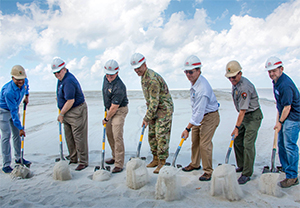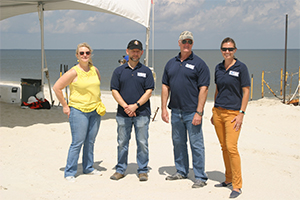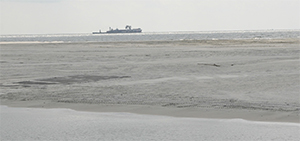
(L to R) Lance Hatten, Regional Director, National Park Service;
Joe Spraggins, Executive Director, Mississippi Department
of Marine Resources; U.S. Rep. Steve Palazzo (Miss.-4th);
Col. Sebastien Joly, Commander, Mobile District, US Army Corps
of Engineers; Gulfport Mayor Billy Hewes; Gulf Islands National
Seashore Superintendent Dan Brown; and Mike Celata,
Gulf of Mexico Region Director, Bureau of Ocean Energy Management.
(Photo: Breault, National Park Service)
Officials from the Bureau of Ocean Energy Management joined the National Park Service, the U.S. Army Corps of Engineers Mobile District, as well as representatives from the Mississippi Congressional delegation, and the State of Mississippi to celebrate the completion of Phase 1 of the restoration of Ship Island, part of the Gulf Islands National Seashore offshore Mississippi, at a ground building ceremony on May 29, 2019.
The celebration marked nearly 50 years since Hurricane Camille, a category 5 hurricane, cut Ship Island in two in August 1969, thus creating the Camille Cut. Ship Island is under the jurisdiction of the National Park Service.
The filling in of the Camille Cut is just one phase of the multi-year Mississippi Coastal Improvement Program (MsCIP).
This project used a cumulative 7.1 million cubic yards from state and federal sediment resources. This project and related work will use up to 19.6 million cubic yards of sand from federal waters, and additional amounts from state waters, making it the largest coastal restoration initiative ever involving the Bureau of Ocean Energy Management’s Marine Minerals Program. BOEM manages the sand and gravel resources in federal waters on the Outer Continental Shelf (OCS), in addition to offshore energy resources. BOEM, the U.S. Army Corps of Engineers (USACE) Mobile District, and the National Park Service coordinated the Phase 1 restoration on Ship Island.
“To be part of this dedication is very special to me personally, and to the bureau. It’s a major step in the largest coastal restoration effort our bureau has supported in my 25-year association with the Marine Minerals Program,” said Renee Orr, Chief of the Office of Strategic Resources and Acting BOEM Deputy Director. “BOEM’s mission goes beyond managing offshore energy. Managing offshore sand resources to restore barrier islands like Ship Island is profoundly relevant to protecting coastal communities and coastal ecosystems.”
Michael Celata, BOEM Gulf of Mexico Regional Director; Barry Obiol, Deputy Regional Director; and regional staff also attended the ceremony.

(L to R) BOEM attendees at the ground-building ceremony:
Renee Orr, Chief of the Office of Strategic Resources
and Acting BOEM Deputy Director; Mike Celeta, BOEM
Gulf of Mexico Regional Director; Barry Obiol, Gulf
of Mexico Deputy Regional Director: and Jessica Mallindine,
Lead MMP Coordinator. (Photo: F. Times, BOEM)
“This collaboration is tremendously important for our bureau, our partners and the residents and visitors to this beautiful area,” said Michael Celata. “BOEM appreciates how important it is to support the long-term recovery of the coastal areas islands, which have suffered extreme erosion since Hurricane Camille, and more recently, after Hurricanes Katrina and Rita.”
“The execution of this important project restoring these islands after the devastation they've suffered from Katrina and Camille wouldn't have been possible without our partners at BOEM and the National Park Service,” said Col. Sebastien Joly, U.S. Army Corps of Engineers Mobile District Commander. “The Corps prides itself on building teams of incredible professionals to take on challenging missions for the Nation, and their talents and contributions come from all our federal and state partners."
Filling in the 2.4 mile Camille Cut breach is part of a long term, concentrated effort to protect and maintain the estuarine ecosystem of the Mississippi Sound. The program also helps to reduce erosion and land loss of the Mississippi barrier islands, thus enhancing and preserving these irreplaceable natural and cultural resources.
Other aspects of MsCIP support the long-term recovery of Hancock, Harrison and Jackson Counties on mainland Mississippi from the devastation caused by Hurricanes Katrina and Rita. Projects are designed to reduce hurricane and storm damage, regulate estuarine salinity levels, preserve fish and wildlife, and prevent shoreline erosion.
These efforts also make great strides to supplement a deficit in coastal sand resources, mitigating for past navigational dredging and sand disposal activities that altered sediment availability and transport along the barrier islands.
The project is part of a comprehensive plan to increase the resiliency of the coast to future storm events and enhance the long-term sand supply in the sand transport system.
Phase 2 will begin this year and will widen and increase the elevation of Ship Island.
More information about MsCIP is located at https://www.boem.gov/Mississippi-Projects/.

